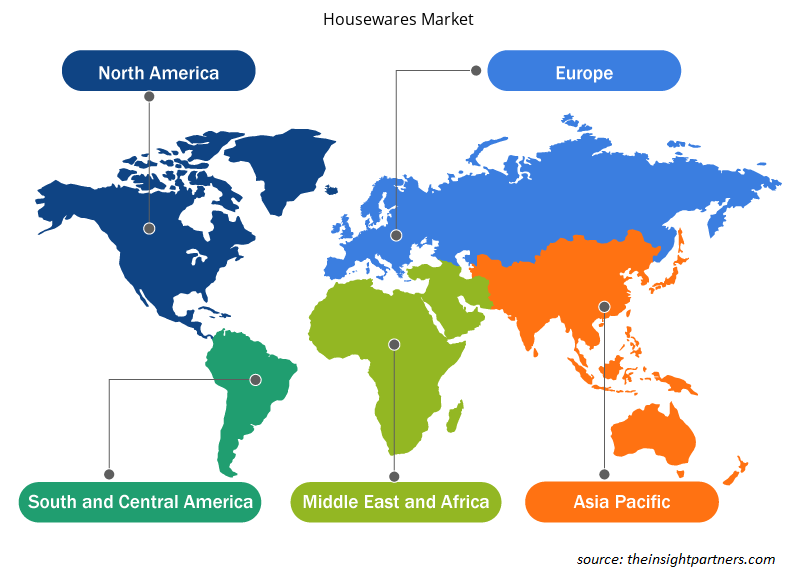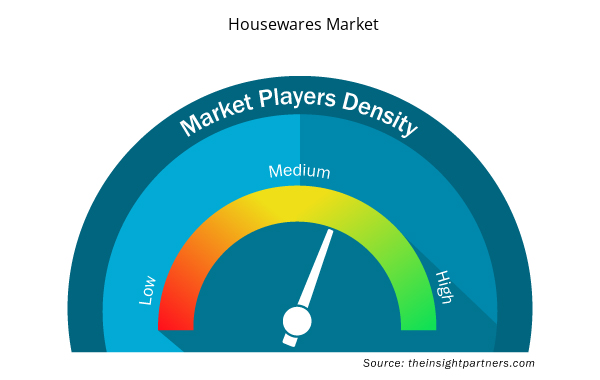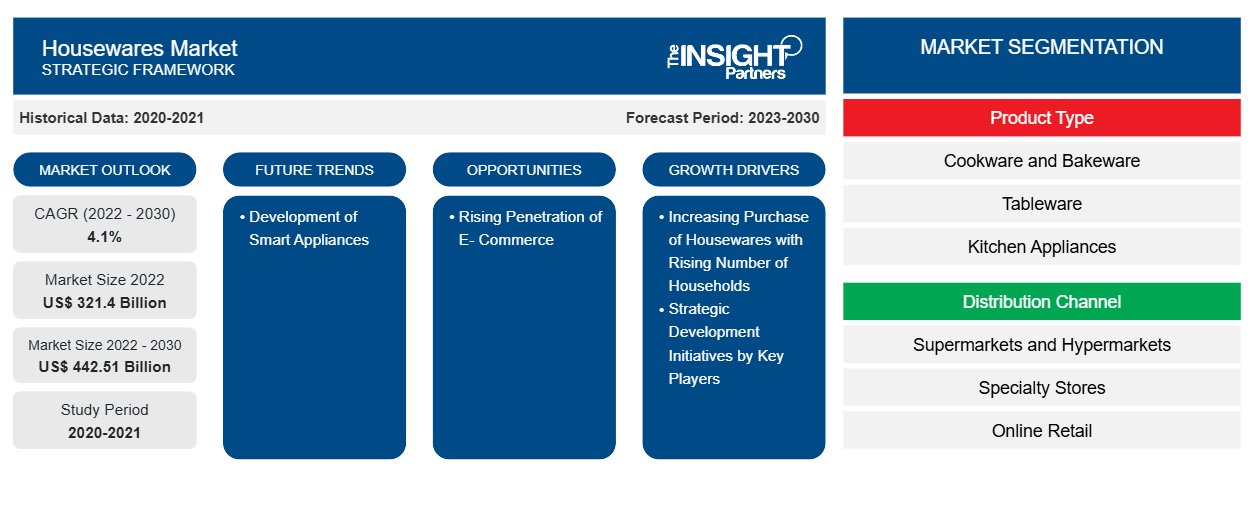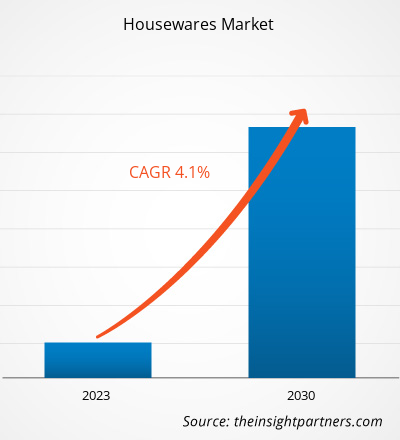[Forschungsbericht] Der Markt für Haushaltswaren wurde im Jahr 2022 auf 321,40 Milliarden US-Dollar geschätzt und soll bis 2030 442,51 Milliarden US-Dollar erreichen; von 2022 bis 2030 wird eine durchschnittliche jährliche Wachstumsrate (CAGR) von 4,1 % erwartet.
Markteinblicke und Analystenansichten:
Haushaltswaren sind Produkte und Gegenstände, die im Haushalt unter anderem zum Kochen, Backen und zur Organisation des Haushalts verwendet werden. Der Haushaltswarenmarkt wächst stetig aufgrund von Faktoren wie veränderten Lebensstilen und mehr Zeit, die zu Hause verbracht wird, was die Nachfrage nach funktionalen und ästhetisch ansprechenden Haushaltswaren ausgelöst hat. Während der COVID-19-Pandemie verbrachten die Menschen mehr Zeit zu Hause und investierten in die Verbesserung ihrer Wohnräume. Darüber hinaus hat ein Anstieg des E-Commerce und von Online-Shopping-Plattformen es den Verbrauchern erleichtert, von zu Hause aus auf eine breite Palette von Haushaltswaren zuzugreifen und diese zu kaufen. Diese Faktoren, gepaart mit innovativen Designs und nachhaltigen Optionen, die von Haushaltswarenunternehmen angeboten werden, begünstigen die Expansion des Haushaltswarenmarktes.
Wachstumstreiber und Herausforderungen:
Dynamische Veränderungen im Lebensstil und die steigende Zahl von Doppelverdienerfamilien führten zu einem Anstieg des verfügbaren Einkommens und einem verbesserten Lebensstandard der Haushalte. Mit steigendem verfügbaren Einkommen geben Verbraucher erhebliche Summen für Haushaltswaren und andere Geräte aus, die das Leben erleichtern. Sie sind oft bereit, neue Produkte zu kaufen, da sie einen einzigartigen Stil haben, der ihre Individualität anspricht, was zu einer höheren Kauffrequenz führt. Darüber hinaus macht eine wachsende Zahl von Einpersonenhaushalten Umbauten im Haus erforderlich, was die Nachfrage nach Haushaltswaren wie Küchengeräten, Kochgeschirr, Backgeschirr, Tafelgeschirr und Badezimmerutensilien ankurbelt.
Darüber hinaus hat die zunehmende Urbanisierung die Nachfrage nach Wohneinheiten und letztlich nach Haushaltswaren angekurbelt. Laut dem US Census Bureau und dem US Department of Housing and Urban Development wurden in den USA im Jahr 2021 etwa 1,3 Millionen Wohneinheiten fertiggestellt, während der Bau von etwa 1,7 Millionen Wohneinheiten im Gange war. Ebenso hat die zunehmende Urbanisierung in europäischen Ländern eine enorme Nachfrage nach Wohnraum geschaffen. Laut der Europäischen Kommission stiegen die Baugenehmigungen für Wohnimmobilien in der Europäischen Union von 2015 bis 2021 um 42,3 %. Im Jahr 2021 verzeichneten Frankreich, Deutschland und Polen die meisten Wohnungsbaubeginne in Europa. Der zunehmende Bau von Wohneinheiten in verschiedenen Ländern steigert also die Nachfrage nach Haushaltswaren weiter. Der zunehmende Kauf von Haushaltswaren zusammen mit der steigenden Zahl von Haushalten treibt also das Wachstum des Haushaltswarenmarktes voran.
Der Haushaltswarenmarkt ist jedoch stark fragmentiert und unorganisiert, da in Entwicklungsländern viele unerschlossene kleine Privatunternehmen und Straßenhändler tätig sind. Laut einem in Business Standards veröffentlichten Artikel waren im Jahr 2020 80 % des Küchenwarenmarkts in Indien unorganisiert. Lokale Kleinunternehmen verwenden minderwertige Rohstoffe zur Herstellung von Haushaltswaren wie Kochgeschirr, Backgeschirr, Badezimmerzubehör und Tischgeschirr. Die Verwendung minderwertiger Rohstoffe führt zu minderwertigen Endprodukten, die anfällig für Beschädigungen sind. Außerdem bieten die Hersteller diese Produkte zu niedrigen Preisen an; daher kauft die Mehrheit der Verbraucher diese Produkte aufgrund der Erschwinglichkeit und leichten Verfügbarkeit. Dieser Faktor führt dazu, dass der Kundenstamm der großen Haushaltswarenhersteller schrumpft.
Darüber hinaus erfüllen lokale Hersteller auf dem unorganisierten Haushaltswarenmarkt häufig nicht die gesetzlichen Vorschriften, was zu Qualitätsproblemen führen und die Wahrnehmung von Haushaltswaren durch die Verbraucher beeinträchtigen kann. Darüber hinaus kann die Verfügbarkeit gefälschter Produkte das Markenimage wichtiger Akteure beeinträchtigen. Somit behindert der Mangel an Einheitlichkeit bei Abläufen und Vorschriften das Wachstum des Haushaltswarenmarktes.
Passen Sie diesen Bericht Ihren Anforderungen an
Sie erhalten kostenlose Anpassungen an jedem Bericht, einschließlich Teilen dieses Berichts oder einer Analyse auf Länderebene, eines Excel-Datenpakets sowie tolle Angebote und Rabatte für Start-ups und Universitäten.
- Holen Sie sich die wichtigsten Markttrends aus diesem Bericht.Dieses KOSTENLOSE Beispiel umfasst eine Datenanalyse von Markttrends bis hin zu Schätzungen und Prognosen.
Berichtssegmentierung und -umfang:
Der globale Haushaltswarenmarkt ist nach Produkttyp, Vertriebskanal und Geografie segmentiert. Basierend auf dem Produkttyp wird der Markt in Koch- und Backgeschirr, Tafelgeschirr, Küchengeräte, Badezimmerbedarf und Sonstiges unterteilt. Nach Vertriebskanal wird der Markt in Supermärkte und Hypermärkte, Fachgeschäfte, Online-Einzelhandel und Sonstiges unterteilt. Nach Geografie ist der globale Haushaltswarenmarkt grob in Nordamerika, Europa, Asien-Pazifik, den Nahen Osten und Afrika sowie Süd- und Mittelamerika segmentiert.
Segmentanalyse:
Basierend auf dem Produkttyp wird der Haushaltswarenmarkt in Koch- und Backgeschirr, Tafelgeschirr, Küchengeräte, Badezimmerutensilien und Sonstiges unterteilt. Das Tafelgeschirrsegment wird voraussichtlich zwischen 2022 und 2030 die höchste durchschnittliche jährliche Wachstumsrate verzeichnen. Das Tafelgeschirrsegment umfasst Produkte wie Geschirr, Besteck, Glaswaren und Serviergeschirr. Ein Anstieg der Nachfrage nach Tafelgeschirr auf dem Haushaltswarenmarkt kann auf veränderte Essgewohnheiten während der COVID-19-Pandemie zurückgeführt werden. Da immer mehr Menschen zu Hause essen, haben sie begonnen, sich auf ästhetisches und funktionales Tafelgeschirr zu konzentrieren, da es das Esserlebnis zu Hause verbessert. Von alltäglichen Mahlzeiten bis hin zu besonderen Zusammenkünften suchen Verbraucher nach Tafelgeschirrsets, die ihr Esserlebnis verbessern. Darüber hinaus spielt die wachsende Wertschätzung für einzigartige und handwerkliche Designs eine bedeutende Rolle bei der Nachfrage nach Tafelgeschirr. Verbraucher fühlen sich zunehmend von handgefertigtem und künstlerisch inspiriertem Tafelgeschirr angezogen, das ihrem Essbereich einen Hauch von Individualität und Persönlichkeit verleiht. Daher hat eine Verlagerung hin zu personalisierteren und optisch ansprechenderen Tafelgeschirroptionen zum Fortschritt des Haushaltswarenmarkts für das Tafelgeschirrsegment beigetragen. Vivo – Villeroy & Boch Group, Corelle, Pyrex, Luminarc und Schott Zwiesel sind einige der führenden Akteure auf dem Markt für Tischgeschirr.
Regionale Analyse:
Der Haushaltswarenmarkt ist in fünf Schlüsselregionen unterteilt: Nordamerika, Europa, Asien-Pazifik, Süd- und Mittelamerika sowie Naher Osten und Afrika. Der Asien-Pazifik-Raum dominierte 2022 den globalen Haushaltswarenmarkt, da der Markt in dieser Region in diesem Jahr auf 120,63 Milliarden US-Dollar geschätzt wurde. Europa ist ein zweiter wichtiger Beitragszahler und hält einen Anteil von mehr als 23 % am Weltmarkt. Der Asien-Pazifik-Raum wird im Zeitraum 2022–2030 voraussichtlich eine beträchtliche durchschnittliche jährliche Wachstumsrate von über 5 % verzeichnen. Die zunehmende Urbanisierung und das verfügbare Einkommen der Mittelschicht sind ein Hauptfaktor, der die Nachfrage nach modernen und praktischen Haushaltswaren, einschließlich fortschrittlicher Küchengeräte und stilvollem Geschirr, antreibt.
Regionale Einblicke in den Haushaltswarenmarkt
Die regionalen Trends und Faktoren, die den Haushaltswarenmarkt im Prognosezeitraum beeinflussen, wurden von den Analysten von Insight Partners ausführlich erläutert. In diesem Abschnitt werden auch die Marktsegmente und die Geografie des Haushaltswarenmarkts in Nordamerika, Europa, im asiatisch-pazifischen Raum, im Nahen Osten und Afrika sowie in Süd- und Mittelamerika erörtert.

- Holen Sie sich die regionalspezifischen Daten für den Haushaltswarenmarkt
Umfang des Haushaltswarenmarktberichts
| Berichtsattribut | Details |
|---|---|
| Marktgröße im Jahr 2022 | 321,4 Milliarden US-Dollar |
| Marktgröße bis 2030 | 442,51 Milliarden US-Dollar |
| Globale CAGR (2022 - 2030) | 4,1 % |
| Historische Daten | 2020-2021 |
| Prognosezeitraum | 2023–2030 |
| Abgedeckte Segmente | Nach Produkttyp
|
| Abgedeckte Regionen und Länder | Nordamerika
|
| Marktführer und wichtige Unternehmensprofile |
|
Marktteilnehmerdichte: Der Einfluss auf die Geschäftsdynamik
Der Haushaltswarenmarkt wächst rasant, angetrieben durch die steigende Endverbrauchernachfrage aufgrund von Faktoren wie sich entwickelnden Verbraucherpräferenzen, technologischen Fortschritten und einem größeren Bewusstsein für die Vorteile des Produkts. Mit steigender Nachfrage erweitern Unternehmen ihr Angebot, entwickeln Innovationen, um die Bedürfnisse der Verbraucher zu erfüllen, und nutzen neue Trends, was das Marktwachstum weiter ankurbelt.
Die Marktteilnehmerdichte bezieht sich auf die Verteilung der Firmen oder Unternehmen, die in einem bestimmten Markt oder einer bestimmten Branche tätig sind. Sie gibt an, wie viele Wettbewerber (Marktteilnehmer) in einem bestimmten Marktraum im Verhältnis zu seiner Größe oder seinem gesamten Marktwert präsent sind.
Die wichtigsten auf dem Haushaltswarenmarkt tätigen Unternehmen sind:
- Bradshaw Home Inc
- Die Denby Pottery Co Ltd
- HF Coors Co Inc
- Inter Ikea Holding Bv
- Hutzler Manufacturing Co Inc
Haftungsausschluss : Die oben aufgeführten Unternehmen sind nicht in einer bestimmten Reihenfolge aufgeführt.

- Überblick über die wichtigsten Akteure auf dem Haushaltswarenmarkt
Auswirkungen der COVID-19-Pandemie:
Die COVID-19-Pandemie behinderte den globalen Haushaltswarenmarkt zunächst aufgrund der Schließung von Produktionsstätten, Arbeitskräftemangel, Unterbrechung der Lieferketten und finanzieller Instabilität. Die Betriebsunterbrechung in verschiedenen Branchen aufgrund der durch den COVID-19-Ausbruch verursachten Konjunkturabschwächung schränkte das Haushaltswarenangebot ein. Darüber hinaus wurden verschiedene Geschäfte geschlossen, was den Verkauf von Haushaltswaren einschränkte. Dennoch begannen die Unternehmen, an Boden zu gewinnen, als zuvor verhängte Beschränkungen in verschiedenen Ländern im Jahr 2021 aufgehoben wurden. Darüber hinaus entspannte die Umsetzung von COVID-19-Impfkampagnen durch Regierungen verschiedener Länder die Situation und führte zu einem Anstieg der Geschäftsaktivitäten weltweit. Mehrere Märkte, darunter der Haushaltswarenmarkt, verzeichneten nach der Lockerung der Ausgangssperren und Bewegungseinschränkungen ein Wachstum.
Wettbewerbslandschaft und Schlüsselunternehmen:
Zu den führenden Akteuren auf dem globalen Haushaltswarenmarkt zählen Bradshaw Home Inc, Denby Pottery, HF Coors Co Inc, Inter Ikea Holding Bv, Hutzler Manufacturing Co Inc, TTK Prestige Ltd, Newell Brands Inc, BSH Hausgeräte GmbH, Kohler Co und Haier US Appliance Solutions Inc.
- Historische Analyse (2 Jahre), Basisjahr, Prognose (7 Jahre) mit CAGR
- PEST- und SWOT-Analyse
- Marktgröße Wert/Volumen – Global, Regional, Land
- Branche und Wettbewerbsumfeld
- Excel-Datensatz


- Fish Protein Hydrolysate Market
- Pressure Vessel Composite Materials Market
- Smart Mining Market
- Sterilization Services Market
- Radiopharmaceuticals Market
- Automotive Fabric Market
- Cut Flowers Market
- Integrated Platform Management System Market
- Smart Parking Market
- Transdermal Drug Delivery System Market

Report Coverage
Revenue forecast, Company Analysis, Industry landscape, Growth factors, and Trends

Segment Covered
This text is related
to segments covered.

Regional Scope
North America, Europe, Asia Pacific, Middle East & Africa, South & Central America

Country Scope
This text is related
to country scope.
Häufig gestellte Fragen
Based on distribution channel, the housewares market is segmented into supermarkets and hypermarkets, specialty stores, online retail, and others. Buying convenience and accessibility are the significant characteristics of supermarkets and hypermarkets. These stores are typically located in areas that are easily accessible by the masses, making it convenient for customers to check and purchase housewares alongside completing the planned shopping. Many supermarkets and hypermarkets have introduced their private label houseware brands, offering consumers superior-quality products at competitive prices. Supermarkets and hypermarkets have extended operating hours, which allows customers to shop at convenient hours. Also, these larger retail establishments often have the advantage of bulk purchasing power, which allows them to offer products at competitive prices. Moreover, supermarkets and hypermarkets tend to stock a variety of houseware in different product types, brands, and varieties, providing customers with a more elaborate range of selections. Walmart, Costco Wholesale Corporation, Tesco, Target, and Bed Bath & Beyond are some of the supermarkets and hypermarket stores offering houseware products.
The major players operating in the global housewares market are Bradshaw Home Inc, Denby Pottery, HF Coors Co Inc, Inter Ikea Holding Bv, Hutzler Manufacturing Co Inc, TTK Prestige Ltd, Newell Brands Inc, BSH Hausgerate GmbH, Kohler Co, and Haier US Appliance Solutions Inc among others.
Dynamic changes in lifestyle and the rising dual income families led to an upsurge in disposable incomes and improved living standards of households. With increasing disposable incomes, consumers spend significant amounts on housewares and other appliances supporting convenient living. They are often willing to purchase new products owing to their unique styles, which appeal to their individuality, resulting in a higher buying frequency. Moreover, a burgeoning number of single-person households triggers the need for home modifications, thereby driving the demand for housewares such as kitchen appliances, cookware, bakeware, tableware, and bathroom essentials. Further, a rise in urbanization has been bolstering the demand for residential units and, ultimately, homewares products. As per the US Census Bureau and the US Department of Housing and Urban Development, the US completed construction of ~1,337,800 housing units in 2021, whereas construction of 1,702,000 housing units was in progress. Similarly, rising urbanization in European countries has created a huge demand for residential housing. For instance, according to the European Commission, between 2015 to 2021, residential building permits increased by 42.3%. In 2021, France, Germany, and Poland had the most residential construction starts in Europe. Thus, the increasing construction of housing units across various countries further boosts the demand for housewares.
Smart appliances can be operated using smartphones or tablets connected via Bluetooth, near–field communication (NFC), or Wi-Fi. These technologies allow users to control their smart appliances via an app. Manufacturers are continuously modifying and developing smart home appliances to support easy lifestyles, which especially appeals to tech-savvy consumers. Well-known brands have been developing devices with automation and hi-tech features for smart homes. Moreover, voice assistants and artificial intelligence (AI) are bringing significant evolution into smart housewares.
Energy-saving appliances, notifications enabled on connected devices, and Wi-Fi capabilities are the key functional upgrades in smart kitchen appliances. For example, smart microwaves can seamlessly download cooking instructions, read barcodes on food products, and offer AI voice assistants to enable a completely hands-free experience. Whirlpool, in January 2022, announced that some of its smart, Wi-Fi-connected microwave would be upgraded to incorporate an air fry mode via a software update to replicate the crispy reheating specifications. Thus, the incorporation of innovative technologies into housewares is likely to bring new trends in the housewares market in the coming years.
Based on product type, the housewares market is categorized into cookware and bakeware, tableware, kitchen appliances, bathroom essentials, and others. The tableware segment is expected to register the highest CAGR during 2022–2030. The tableware segment includes products such as crockery, cutlery, glassware, and serveware. A surge in demand for tableware in the housewares market can be attributed to transformed dining habits during the COVID-19 pandemic. With more people dining at home, people have started focusing on aesthetic and functional tableware, as it enhances home dining experiences. From everyday meals to special gatherings, consumers are looking for tableware sets that elevate their dining experience. Furthermore, the growing appreciation for unique and artisanal designs plays a significant role in driving the demand for tableware. Consumers are increasingly drawn to handcrafted and artistically inspired tableware pieces that bring a touch of individuality and personality to their dining settings. Thus, a shift toward more personalized and visually striking tableware choices has contributed to the progress of the housewares market for the tableware segment. Vivo - Villeroy & Boch Group, Corelle, Pyrex, Luminarc, and Schott Zwiesel are a few of the prominent players operating in the market for tableware.
Trends and growth analysis reports related to Consumer Goods : READ MORE..
The List of Companies - Houseware Market
- Bradshaw Home Inc
- The Denby Pottery Co Ltd
- HF Coors Co Inc
- Inter Ikea Holding Bv
- Hutzler Manufacturing Co Inc
- TTK Prestige Ltd, Newell Brands Inc
- BSH Hausgerate Gmbh
- Kohler Co
- Haier US Appliance Solutions Inc.
The Insight Partners performs research in 4 major stages: Data Collection & Secondary Research, Primary Research, Data Analysis and Data Triangulation & Final Review.
- Data Collection and Secondary Research:
As a market research and consulting firm operating from a decade, we have published and advised several client across the globe. First step for any study will start with an assessment of currently available data and insights from existing reports. Further, historical and current market information is collected from Investor Presentations, Annual Reports, SEC Filings, etc., and other information related to company’s performance and market positioning are gathered from Paid Databases (Factiva, Hoovers, and Reuters) and various other publications available in public domain.
Several associations trade associates, technical forums, institutes, societies and organization are accessed to gain technical as well as market related insights through their publications such as research papers, blogs and press releases related to the studies are referred to get cues about the market. Further, white papers, journals, magazines, and other news articles published in last 3 years are scrutinized and analyzed to understand the current market trends.
- Primary Research:
The primarily interview analysis comprise of data obtained from industry participants interview and answers to survey questions gathered by in-house primary team.
For primary research, interviews are conducted with industry experts/CEOs/Marketing Managers/VPs/Subject Matter Experts from both demand and supply side to get a 360-degree view of the market. The primary team conducts several interviews based on the complexity of the markets to understand the various market trends and dynamics which makes research more credible and precise.
A typical research interview fulfils the following functions:
- Provides first-hand information on the market size, market trends, growth trends, competitive landscape, and outlook
- Validates and strengthens in-house secondary research findings
- Develops the analysis team’s expertise and market understanding
Primary research involves email interactions and telephone interviews for each market, category, segment, and sub-segment across geographies. The participants who typically take part in such a process include, but are not limited to:
- Industry participants: VPs, business development managers, market intelligence managers and national sales managers
- Outside experts: Valuation experts, research analysts and key opinion leaders specializing in the electronics and semiconductor industry.
Below is the breakup of our primary respondents by company, designation, and region:

Once we receive the confirmation from primary research sources or primary respondents, we finalize the base year market estimation and forecast the data as per the macroeconomic and microeconomic factors assessed during data collection.
- Data Analysis:
Once data is validated through both secondary as well as primary respondents, we finalize the market estimations by hypothesis formulation and factor analysis at regional and country level.
- Macro-Economic Factor Analysis:
We analyse macroeconomic indicators such the gross domestic product (GDP), increase in the demand for goods and services across industries, technological advancement, regional economic growth, governmental policies, the influence of COVID-19, PEST analysis, and other aspects. This analysis aids in setting benchmarks for various nations/regions and approximating market splits. Additionally, the general trend of the aforementioned components aid in determining the market's development possibilities.
- Country Level Data:
Various factors that are especially aligned to the country are taken into account to determine the market size for a certain area and country, including the presence of vendors, such as headquarters and offices, the country's GDP, demand patterns, and industry growth. To comprehend the market dynamics for the nation, a number of growth variables, inhibitors, application areas, and current market trends are researched. The aforementioned elements aid in determining the country's overall market's growth potential.
- Company Profile:
The “Table of Contents” is formulated by listing and analyzing more than 25 - 30 companies operating in the market ecosystem across geographies. However, we profile only 10 companies as a standard practice in our syndicate reports. These 10 companies comprise leading, emerging, and regional players. Nonetheless, our analysis is not restricted to the 10 listed companies, we also analyze other companies present in the market to develop a holistic view and understand the prevailing trends. The “Company Profiles” section in the report covers key facts, business description, products & services, financial information, SWOT analysis, and key developments. The financial information presented is extracted from the annual reports and official documents of the publicly listed companies. Upon collecting the information for the sections of respective companies, we verify them via various primary sources and then compile the data in respective company profiles. The company level information helps us in deriving the base number as well as in forecasting the market size.
- Developing Base Number:
Aggregation of sales statistics (2020-2022) and macro-economic factor, and other secondary and primary research insights are utilized to arrive at base number and related market shares for 2022. The data gaps are identified in this step and relevant market data is analyzed, collected from paid primary interviews or databases. On finalizing the base year market size, forecasts are developed on the basis of macro-economic, industry and market growth factors and company level analysis.
- Data Triangulation and Final Review:
The market findings and base year market size calculations are validated from supply as well as demand side. Demand side validations are based on macro-economic factor analysis and benchmarks for respective regions and countries. In case of supply side validations, revenues of major companies are estimated (in case not available) based on industry benchmark, approximate number of employees, product portfolio, and primary interviews revenues are gathered. Further revenue from target product/service segment is assessed to avoid overshooting of market statistics. In case of heavy deviations between supply and demand side values, all thes steps are repeated to achieve synchronization.
We follow an iterative model, wherein we share our research findings with Subject Matter Experts (SME’s) and Key Opinion Leaders (KOLs) until consensus view of the market is not formulated – this model negates any drastic deviation in the opinions of experts. Only validated and universally acceptable research findings are quoted in our reports.
We have important check points that we use to validate our research findings – which we call – data triangulation, where we validate the information, we generate from secondary sources with primary interviews and then we re-validate with our internal data bases and Subject matter experts. This comprehensive model enables us to deliver high quality, reliable data in shortest possible time.


 Holen Sie sich ein kostenloses Muster für diesen Bericht
Holen Sie sich ein kostenloses Muster für diesen Bericht